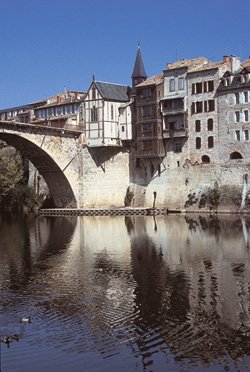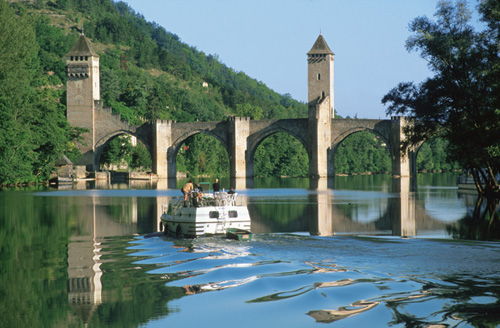 |
||
The river Lot’s source is 1200
m up Mont Lozère. The Lot is extremely sinuous, travelling only
200 km as the bird flies in its 481 km length meander down the valley,
before mingling its waters with the river Garonne at Aiguillon. All
along the river’s course, the Lot Valley reveals hidden landscapes
where human activity, like the valley itself, has been forged by the
waterway for centuries. Local traditions live on in picturesque villages where the typical “art de vivre” of south-west of France is as vigorous as ever. Leisure and sporting activities abound in this untouched natural heaven. Weither you’re looking for energic water sports, rambling and horse riding, or you’re simply keen to take it easy and stroll through the ancient chateaux and cliff-perched hamlets, the area really does have something for everyone and for all ages. Add the famous country cooking and local fare, the spendidly varied cultural choices and many seasonal celebrations and you’ll soon realise there’s more to be seen here than at first meets the eye. which is why visitors say there’s such a Lot to come back to. |
||
 |
||
The Lot Valley is perfect for just
“letting yourself go”, everywhere. Whether you’re
looking for flatlands and fields, forests, fens, gorges and valleys,
moors and foothills or alluvial plains, the variety of the Lot Valley
coutryside present possibly the most diverse range of natural surroundings
to be found in France within a short distance. The river’s winding
route runs some 20 different listed “natural regions”. Take a boat or a canoe on the river and wherever you disembark, at whatever village you moor, you’re sure of finding new scenes, new excursions, new things to do at every turn in the river. |
 |
|
 |
||
The Départements through which
the river Lot flows are, from its source, Lozère, Cantal, Aveyron,
Lot and Lot-et-Garonne. In 1980, the five local government bodies set up an organisation called l’Entente to co-ordinate and run Lot Valley development. An ambitious economic development progrmme covering waterway tourism and the valorisation of the environment fixed the major objectives : to facilitate the growth of a new tourist destination, while preserving the very environment on which the tourist trade here depends. The goal has been to encourage the emergence of integrated tourism combining boats, river sports, the art and heritage, leading ultimately to the creation of the largest European waterways zone: Lor, Baïse, Lateral Canal and Canal du Midi. An inter-regional convention was signed for a 2000-2006 programme, co-financed by EU, the State, the Regions and the Départements for an investment of € 112 million. |
||